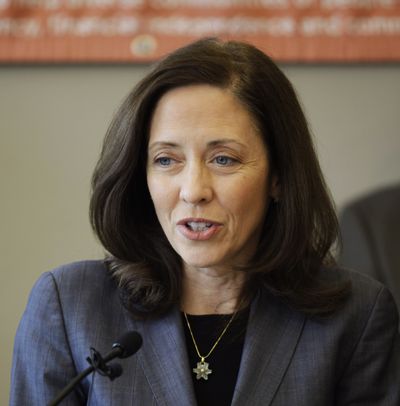Washington farmers sought for camelina fuel crop
Program pays camelina growers, but deadline near

Eastern Washington farmers can line up over the next three weeks for a federal program that pays them to grow camelina, a seed crop that some researchers consider a potentially cost-effective alternative to overseas oil.
During a Tuesday event in Spokane Valley, Sen. Maria Cantwell, D-Wash., said the new Agriculture Department effort called BCAP ( Biomass Crop Assistance Program) is the first commercial-scale farm initiative to jump-start the creation of a camelina-to-fuel industry.
Unless many more Western U.S. farmers grow camelina, few companies will invest money in production facilities to turn camelina oil into biodiesel, or its higher-value option, “green” aviation fuel, Cantwell said.
The BCAP program will pay Eastern Washington farmers a total of up to $4.5 million in crop support over five years to grow camelina on their land. The program’s largest target growing areas are California, Washington and Montana; in those three states, farmers could receive up to $20 million over five years.
But there’s a hitch, Cantwell said: Growers must commit to the program by Sept. 16. The USDA funds are only for the current fiscal year, which ends on Sept. 30.
“So that’s what I’m doing today,” Cantwell added, “trying to get the word out quickly.”
Cantwell and several other speakers offered a litany of reasons why growers might see camelina as a perfect rotation crop. Compared to canola, a similar seed crop, camelina grows easily in dry land because it requires little water. It’s largely disease resistant. Its meal is a useful animal feedstock. When the crushed oil is refined, it can be blended into high-quality aviation fuel.
But speakers also noted few farmers in Washington grow the crop, since the camelina market is in its infancy.
Cantwell said farmers in Eastern Washington, including Spokane County, could plant as many as 11,000 acres with federal assistance. With time, that level of production could convince other producers to follow suit, bolstering the camelina-to-jet-fuel program. Cantwell is a biofuel advocate who’s a member of the Senate Energy Committee.
“The green jet fuel industry can mean more jobs in Eastern Washington,” she said. “But first we have to use this program to help establish the market.”
So far, though, response by Eastern Washington growers to the camelina-jet fuel program has been minimal, said Rod Hamilton, with the USDA Farm Service Agency.
“For one thing, this proposal got about 24,000 comments (nationwide) when it was put out for public review,” Hamilton said. That large volume of responses forced federal program managers to take much longer to sort out grower concerns and implement the rules to run it, he said.
“We’ve also been affected by the late spring and the later growing season,” Hamilton said.
Lacrosse wheat farmer Steve Camp joined Cantwell at the Tuesday event, and said he regards camelina as a crop that will have a major role to play in the nation’s adoption of a biodiesel and biofuel industry. “It grows almost like a weed,” said Camp, who has been growing camelina as a rotation crop alongside his 1,200 acres of wheat and uses the biofuel it produces to run all of his farm equipment.
But Camp said he’s not ready to sign up for the new support program.
“As the program was sent out, it looked like a rose,” Camp said. “But what you get is a dandelion, when you dig in and see what the strings attached to the program are.”
In a basic agriculture support program, the farmer is assured a certain dollar amount based on acres used, he said. “The way I read it, and I’ll stand corrected if I read it wrong, this is not a straight-support system.” Farmers must commit to partnerships with processing facilities or face monetary penalties, for instance.
“Like many government programs, it’s not any clearer than mud,” Camp said.